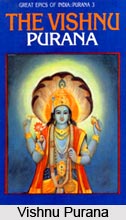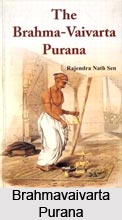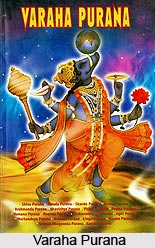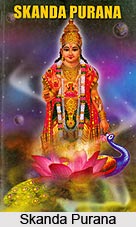 Classification of Puranas has been made according to the importance of the respective Puranas. Accordingly, they are divided into Mahapuranas and Upapuranas. According to myths and the traditional scriptures, both of these are said to narrate five subjects, namely Sarga (deals with the mystery of Creation), Pratisarga (deals with the process of recreation after dissolution), Vamsha (deals with the genealogy of kings and sages), Manvantara (creation of human races and first human beings) and Vamshanucharita (Dynastic histories). In the Puranas themselves the number of existing Puranas "composed by Vyasa" is unanimously given as eighteen, and also with reference to their titles there is almost complete agreement. Most of the Puranas also agree in the order in which they enumerate the eighteen Puranas. The eighteen Puranas in order are Brahma Purana, Padma Purana, Vishnu Purana, Vayaviya or Shiva Purana, Bhagavata Purana, Naradiya Purana, Markandeya Purana, Agneya Purana, Bhavisyat or Bhavishya Purana, Brahmavaivarta Purana, Linga Purana, Varaha Purana, Skanda Purana, Vamana Purana, Kurma Purana, Matsya Purana, Garuda Purana and Brahmanda Purana.
Classification of Puranas has been made according to the importance of the respective Puranas. Accordingly, they are divided into Mahapuranas and Upapuranas. According to myths and the traditional scriptures, both of these are said to narrate five subjects, namely Sarga (deals with the mystery of Creation), Pratisarga (deals with the process of recreation after dissolution), Vamsha (deals with the genealogy of kings and sages), Manvantara (creation of human races and first human beings) and Vamshanucharita (Dynastic histories). In the Puranas themselves the number of existing Puranas "composed by Vyasa" is unanimously given as eighteen, and also with reference to their titles there is almost complete agreement. Most of the Puranas also agree in the order in which they enumerate the eighteen Puranas. The eighteen Puranas in order are Brahma Purana, Padma Purana, Vishnu Purana, Vayaviya or Shiva Purana, Bhagavata Purana, Naradiya Purana, Markandeya Purana, Agneya Purana, Bhavisyat or Bhavishya Purana, Brahmavaivarta Purana, Linga Purana, Varaha Purana, Skanda Purana, Vamana Purana, Kurma Purana, Matsya Purana, Garuda Purana and Brahmanda Purana.
 It is quite strange to note that this list of "eighteen Puranas" is given in each one of them, as though none were the first and none the last, but all had already existed when each separate one was composed. All these Puranas point out in extravagant terms the advantages to be attained both in this world and in the world beyond, by reading and hearing these works. In some places the length (number of Slokas) of the various Puranas is mentioned, but the texts which have come down are mostly shorter.
It is quite strange to note that this list of "eighteen Puranas" is given in each one of them, as though none were the first and none the last, but all had already existed when each separate one was composed. All these Puranas point out in extravagant terms the advantages to be attained both in this world and in the world beyond, by reading and hearing these works. In some places the length (number of Slokas) of the various Puranas is mentioned, but the texts which have come down are mostly shorter.
Of the eighteen Puranas, six are Sattvic Puranas which glorify Lord Vishnu, the symbol of eternity; six are categorized as Rajashik and glorify Lord Brahma, the creator; six are Tamasic and glorify Shiva. In one passage of the Padma Purana (I, 62) all of the eighteen Puranas are enumerated as parts of Vishnu`s body (the Brahma Purana is his head, the Padma Purana is his heart, etc.), and are thus all stamped as sacred books. In another text of the same work, on the other hand, one can find the Puranas classified according to the three Gunas from the standpoint of Vaishnavism. According to this classification, only the Vishnuite Puranas (Vishnu, Narada, Bhagavata, Garuda, Padma, Varaha) are of the quality of "goodness" (Sattvika) and lead to salvation. The Puranas dedicated to Brahman (Brahmanda, Brahmavaivarta, Markandeya, Bhavisya, Vamana, Brahma) are of the quality of "passion" (rajasa) and only serve to attain heaven, while the Puranas in praise of Shiva (Matsya, Kurma, Linga, Siva, Skanda, Agni) are described as charged with "darkness" and as leading to hell. The texts which have come down to us, only partially agree with this artificial classification. All this is additional confirmation of the fact that none of the Puranas has come down to us in its original form.
 Besides the eighteen Puranas, which are often called the "great Puranas" (Mahapurana), some of the Puranas themselves make mention of so-called Upapuranas or "secondary. Puranas," whose number also is occasionally given as eighteen. However, there is no definite agreement as regards the titles of the Upapuranas. No uniformity in the enumeration of the Upa Puranas is noticed. This is because these Upa Puranas were more sectarian in character, and of a composite nature. Since these Upa Puranas are composed much later than these traditional Maha Puranas, there historical value is less in comparison to the traditional ones. This possibly indicates that while there was a definite tradition about the existence of eighteen Puranas, any modern religious text could assume the title of an Upapurana if the author did not declare his work as a part of one of the eighteen Puranas.
Besides the eighteen Puranas, which are often called the "great Puranas" (Mahapurana), some of the Puranas themselves make mention of so-called Upapuranas or "secondary. Puranas," whose number also is occasionally given as eighteen. However, there is no definite agreement as regards the titles of the Upapuranas. No uniformity in the enumeration of the Upa Puranas is noticed. This is because these Upa Puranas were more sectarian in character, and of a composite nature. Since these Upa Puranas are composed much later than these traditional Maha Puranas, there historical value is less in comparison to the traditional ones. This possibly indicates that while there was a definite tradition about the existence of eighteen Puranas, any modern religious text could assume the title of an Upapurana if the author did not declare his work as a part of one of the eighteen Puranas.
Classification of Mahapuranas
The Maha Puranas can be classified into the following divisions: -
Brahma Purana (depicting the creation of the world); Padma Purana (it depicts sage Pulastya describing the religion and true essence of religion to Bhisma and description of cosmos with special reference to Bharat varsa); Vishnu Purana (considered as Puranratna, it introduced the conception of Yugas, battle between the Asuras and the Devas, and the avatars of Lord Vishnu who came to save the world), Bhagavata Purana (this is concerned with the tales of the exploits and deeds of the Vishnu avatars and the tenth canto narrates the deeds of Lord Krishna as a child), Naradiya Purana (composed as a conversation between sage Lord Narad and Sanat Kumar, this Purana depicts the description of various pilgrimages), Markandeya Purana (composed in the style of a dialogue between the sage Jaimini and the sage Markandeya containing the accounts of the period of human beings and glorify the great goddess. It includes the account of the Puranic genealogies), Agni Purana (includes the description of various incarnations of Vishnu and number of verses dealing with ritual worship, cosmology history, warfare, and even sections on Sanskrit grammar, meter, law, medicine, and martial arts etc. it was recited by Agni to sage Vasistha), Bhavishya Purana (contains tales signifying the prophecies of future. It also includes legendary stories regarding the royal genealogies), Brahmavaivarta Purana (deals with the creation of universe and all beings, relates to description and histories of different goddesses and also the life and deeds of Ganesha and Lord Krishna), Varaha Purana (depicts the exploits of the Varaha as the incarnation of Lord Vishnu, who rescue the earth), Linga Purana (deals with the origin of cosmos, origin of linga, emergence of Brahma and Vishnu. It also includes the teaching of lord Shiva signifying the importance of worship of Linga), Skanda Purana (depicts the life and deeds of the Kartikeya and contain parables, legends and stories, with multiple versions), Vamana Purana (depicts the stories regarding the Vamana incarnation of Lord Vishnu on earth), Kurma Purana (deals with the Kurma avatar or the tortoise incarnation of Lord Vishnu, who holds the Mainaka mountain in its back during the churning of the sea), Matsya Purana (depicts the story of the Matsya avatar incarnation of Lord Vishnu, who appeared before sage, Manu, a Surya Vamshi and save the world from Rasatal), Garuda Purana (deals with the details of the astronomy, medicine, grammar, gemstone structure and the qualities. It is a Vaishnava Purana), Brahmanda Purana (containing the detail description of creation of cosmos, discussion of time, details of Kalpa and Yuga, religion and geography, description of dynastic genealogies and Adhyatma Ramayana).
 Classification of Upapuranas
Classification of Upapuranas
After a thorough consideration the scholars have classified the Upa Puranas into eighteen parts. The Upa Puranas are classified into the following divisions:- Sanatkumar, Narasimha, Nanda, Shivadharma, Durvasa, Naradiya, Kapila, Vamana,Ushanas, Manava, Varuna, Kali Maheshvara, Samba, Saura, Farashara, Maricha, Bhargava etc.
It may be mentioned here that the Panchalakshana definition is considered as the standard to determine the date and chronology of the Puranas. The Puranas can be classified into ancient and late according to their degree of conformity to this definition. The less the number of additions to the five characteristics mentioned in the Amarakosha, the older the Purana. Hence judging from this point of view Vayu, Brahmanda, Matsya and Vishnu are considered as the ancient group of Puranas. The Puranas can also be classified on the preferential basis of the scholars in the later ages. For this, several other facts should be taken into consideration.Those which mainly deal with Tirthas and Vratas such as Padma, Skanda and Bhavishya, can be ascribed to the groups of the traditional Puranas. Brahmanda Puranas can be included in the groups of the historical Puranas. The Linga, Vamana and Markandeya can be categorized in the group of the Sectarian Puranas. The first two are Shaiva Puranas while the last one principally deals with Devi. The revised version of the Old Puranas can be ascribed to the Varaha, Kurma and Matsya.
Thus discussed above is the classification of the Indian Puranas.












